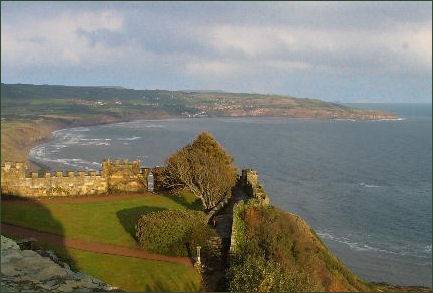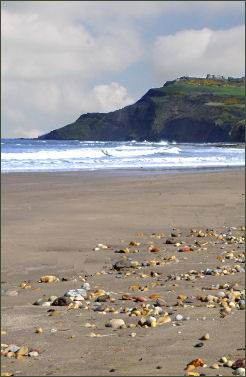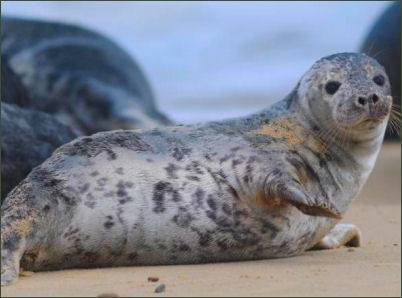Ravenscar
OS grid reference:- NZ 980 014
 The small coastal village of Ravenscar is set in a dramatic clifftop location and lies within the stunning North York Moors National Park. Ravenscar is situated around 10 miles (16 km) to the north of the popular seaside resort of Scarborough. Until the early twentieth century the village was known as Peak.
The small coastal village of Ravenscar is set in a dramatic clifftop location and lies within the stunning North York Moors National Park. Ravenscar is situated around 10 miles (16 km) to the north of the popular seaside resort of Scarborough. Until the early twentieth century the village was known as Peak.
 Ravenscar was the location of a late fourth century Roman signal station, part of a chain of such stations that extended along the Yorkshire coast.
Ravenscar was the location of a late fourth century Roman signal station, part of a chain of such stations that extended along the Yorkshire coast.
To the north of the village stand the old Peak alum works, once an important part of the dyeing industry, alum that was used in the textile industry to fix dyes on cloth and in the tanning industry to make leather supple and more durable. The works are now a fascinating National Trust site. At the edge of Ravenscar is a now disused windmill, known as Peak Mill, it dates back to 1858.
In the Edwardian era, there were plans to turn the village into a holiday resort to rival nearby Scarborough. Roads were built and some houses were constructed. However due to the long walk to its rocky beach, Ravenscar never achieved popularity, and the development was never completed leading Ravenscar to be referred to as 'the town that never was'.
Perhaps the best way to explore Ravenscar is to collect a Tracker Pack from the National Trust visitor centre. The pack helps visitors learn about the local heritage and wildlife. The path which leads down to the beach is rather steep, but it is a lovely secluded beach, were grey seals are often sighted and a good location to search for fossils.
The small village church, dedicated to St Hilda (pictured left) dates to the nineteenth century and contains an impressive reredos. The Raven Hall Hotel, perched broodingly on the clifftop, was once a home owned by King George III's physician, Dr Francis Willis. Dramatically situated 600 feet above sea level, it overlooks scenic Robin Hood's Bay and is midway between Whitby and Scarborough, Raven Hall is in an inspirational and historical setting.
In the sixteenth century Peak House Farm, owned by the Beswick family, occupied the site of a fifth century Roman fort. In 1774 Raven Hall was built on the site for Captain William Childs of London, a captain in the King's Regiment of Light Dragoons, who came to Yorkshire with the army and became the owner of the Alum Works at Ravenscar.
 On his death in 1829 the hall passed to his daughter Ann Willis, who was married to Dr Francis Willis, had become wealthy from treating George III's maladies and other royalty, ncluding the Queen of Portugal, for their medical conditions. Ann's son, the eccentric Rev Dr Richard Willis, built the gardens and battlements which surround the house, but quickly squandered his parent's wealth.
On his death in 1829 the hall passed to his daughter Ann Willis, who was married to Dr Francis Willis, had become wealthy from treating George III's maladies and other royalty, ncluding the Queen of Portugal, for their medical conditions. Ann's son, the eccentric Rev Dr Richard Willis, built the gardens and battlements which surround the house, but quickly squandered his parent's wealth.
In 1845 the property passed into the hands of William Hammond of London. Hammond became a prominent local benefactor, building the village church and the windmill. He became a director of the Scarborough to Whitby railway line, insisting that it passed through his property via a tunnel and that Ravenscar should have a station. On his widow's death in 1890 the estate was sold to the Peak Estate Company for development as a holiday resort. The house was extended for use as a hotel from 1895, and its golf course opened in 1898. It was sold by auction in 1911 after the company went bankrupt, and after several changes of ownership and use as a billet in wartime it was acquired by the present owners, who are associated with Classic Hotels
A National Trail, the 110-mile (180 km) long Cleveland Way, passes through Ravenscar, which is also the eastern terminus of the Lyke Wake Walk. The official end of the Walk is at a point where the path meets the coast road.
